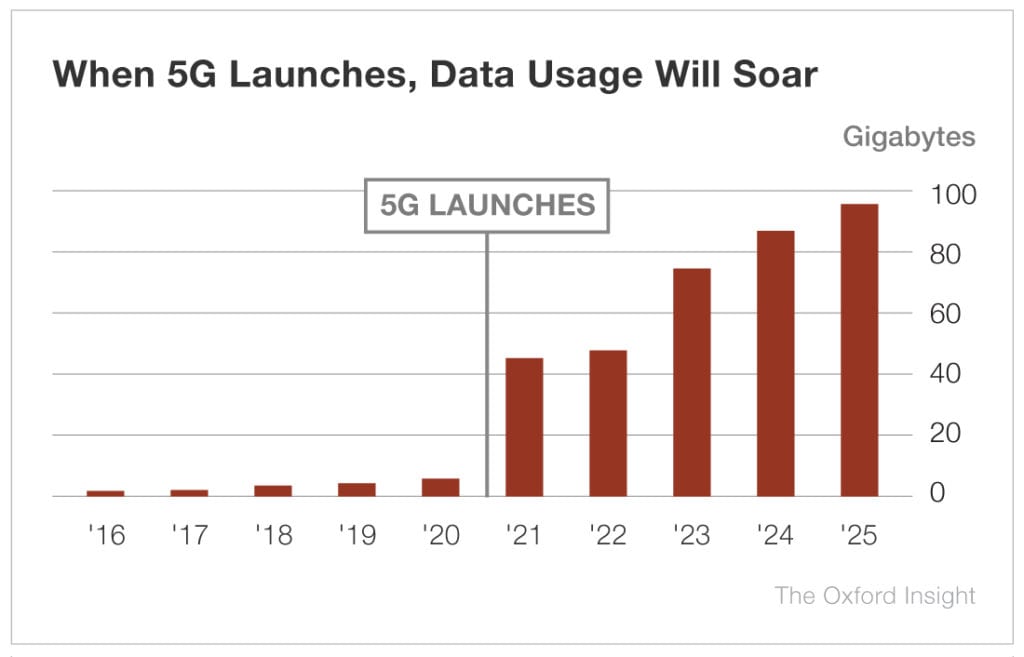A Massive Post-Pandemic Opportunity
A number of bizarre conspiracy theories about 5G technology and the coronavirus pandemic are now making the rounds on the internet.
These theories variously claim that 5G mobile technology somehow causes the virus or facilitates its spread or offer other unscientific rubbish that frankly makes no sense.
But I have my own theory about 5G and the pandemic. And it’s almost certainly a better opportunity for investors than the tinfoil hat stuff.
It’s a simple yet potentially powerful idea: This global pandemic may be the catalyst that truly launches us into the 5G era.
5G technology was already being rolled out when the pandemic struck. Yet the technology was moving somewhat slowly. Only a fraction of the mobile phones purchased last year support 5G networks.
But it now appears the pandemic will render superfast mobile connections and high internet bandwidth – aka 5G technology – absolute necessities in a post-pandemic world.
Going Zoom
By now, of course, most Oxford Insight readers have probably participated in a group video call or teleconference, whether it’s for a work meeting or just to catch up with friends and family. In my house, Zoom is suddenly part of our lexicon. It can be an exciting verb, as in “let’s Zoom with Grandma!” Or a disappointing adjective, as in “I have another Zoom call for science class.”
The Zoom app and apps like it are being widely adopted for virtual happy hours, virtual classrooms, business meetings and even stay-at-home church services. Zoom was downloaded 2.13 million times on March 23, right around the time that lockdowns began to take effect across the globe.

As a result, Zoom (Nasdaq: ZM) stock has risen 108% year to date.
But Zoom is just the beginning. Many other conferencing apps are challenging it for a piece of the rapidly expanding videoconferencing pie, from Google’s Hangouts and Duo to Houseparty, Skype and dozens of others.
I enjoy these videoconferences. I’ve had more contact with old college buddies in the last four weeks than I did in the previous decade. I plan to continue them after the pandemic fades.
And it’s almost certain that anxieties about the virus and other health dangers will linger for years after the virus has faded. There’s a precedent for this. After the 2008-2009 financial crisis ended, worries about the economy receded only 10% per year, rather than switching off suddenly, according to research firm Ipsos.
I don’t expect people will start hugging each other and shaking hands again for a while after the pandemic fades. Similarly, many people will remain wary of large gatherings and crowded places. Online gatherings will not replace these for good, of course, but they will be a fixture of our society going forward.
As video calls replace normal phone calls, and more and more people begin to use these platforms on mobile devices, bandwidth is sure to be an issue. The higher frequencies that come with 5G mobile will deliver the huge improvements in speed and bandwidth needed.
That’s probably why Verizon (NYSE: VZ) is purchasing videoconferencing platform BlueJeans and plans to build it into the company’s 5G offering for consumers and businesses.
Doctor Digital
Healthcare – also thrust to center stage by the pandemic – will be another huge market for 5G technology.
A week ago my son had a telehealth appointment with his dermatologist. It was quick and easy. The doctor could see him clearly and make a diagnosis and a prescription. There was no need to drive anywhere or interact with other patients who may be sick or contagious.
With 5G, appointments like this can happen from a mobile phone anywhere. Large medical documents like MRIs and other images can also be transmitted – nearly instantly. Wearable monitors can gather patient data and alert health professionals before a small problem becomes a big one.
For these and other reasons, telemedicine is expected to grow at a 16.5% annual rate through 2023, according to research firm Market Research Future.
Excuse me. That’s what was expected, before the pandemic struck. That rate is sure to accelerate as more and more people wish to avoid face-to-face communication.
A New Reality
Mobile data usage was already expected to soar in the coming years as a result of the 5G revolution. But major global events like wars and epidemics change things, sometimes dramatically.
And this pandemic may well reverse the direction of causality there. Data usage will soar because of the pandemic. And that will accelerate the demand for, rollout of and use of 5G.
“All of these technologies have an ever-increasing need for faster speeds and greater connectivity,” Energy Expert David Fessler tells me. “And the new 5G mobile communications platform is going to solve those problems and many others.”

5G use was already expected to launch broadly this year, as you can see in the chart above, with data usage soaring from 2020 to 2021.
And pre-pandemic projections were that the wireless 5G market would grow to $250 billion globally by 2025. That market includes 5G device makers, chipmakers, part suppliers, handset makers, infrastructure suppliers and, of course, mobile providers.
But the pandemic – and the lingering anxieties and new habits that will be its legacy – could accelerate that market growth beyond all expectations.
When I think of technologies like 5G, I think of Dave’s Three Laws of Technology:
- Technology marches on.
- When it comes to technology, change happens much faster than anyone expects it will.
- New technology is almost always disruptive and transformative.
Sounds about right. 5G to a T.
About Matt Benjamin
Matt has worked as an editorial consultant to the International Monetary Fund, the World Bank, the Economist Intelligence Unit and other global macro-institutions. He wrote about markets and economics for U.S. News & World Report, Bloomberg News and Investor’s Business Daily, among other publications. He also worked for several years as head of political economy for a Financial Times-owned macroeconomic consulting firm, advising hedge funds around the world. Matt’s claim to fame is that he’s interviewed two U.S. presidents and has spoken with five Federal Reserve Chairs from Paul Volcker through Jerome Powell. Matt also served as The Oxford Club’s Editorial Director for two years.






